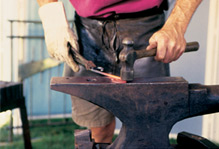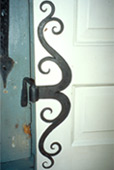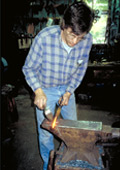Craft Traditions – Blacksmithing
In Colonial times community blacksmiths created just about everything made of metal-nails, plows, pots, knives, hinges and latches for doors and windows, kitchen utensils, and horseshoes.

Repeated pounding helps shape
the iron and drive off impurities.
Blacksmiths were respected for their "Yankee ingenuity." Their ability to figure out how things work and working out ways to produce things more efficiently contributed to the Industrial Revolution.
A blacksmith shapes iron by first softening it in a very hot fire-usually produced with coal. The fire is built in a forge usually made from brick or steel. Bellows help to make a fire hotter, while a rake tool called a washer helps spread the coals to cool it down. A skilled blacksmith can judge just how hot and malleable a piece of metal is by its color-white, yellow, orange, red or purple. The softened iron is shaped or turned into wrought iron by pounding it against a heavy steel anvil. A variety of tongs and hammers are used for different jobs.

An elaborate
door hinge
by Russell Pope.
The automated manufacturing that came with the Industrial Revolution of the mid-1800s took over many of the traditional tasks of the blacksmith. While technological advancements closed down many blacksmith shops around the country, in New Hampshire, the interest in preserving old buildings provided opportunities for blacksmiths to continue making both practical and decorative items-such as gates, door latches, hinges, and light fixtures.

Blacksmith
Russell Pope
pounding on a
piece of
wrought iron
on his anvil.
In the 1970s, a renewed appreciation for handmade crafts prompted a rebirth of blacksmithing in the United States and especially in New Hampshire. As with other crafts, blacksmiths find it helpful to band together to share information with each other on skills and techniques, strengthen their marketing networks, and educate people on the value of their work. The Artists Blacksmith Association of North America was founded in 1973 and the New England Blacksmiths (NEB) in 1978.
Today, NEB has over 300 members, ranging from professional blacksmiths to people who enjoy it more as a hobby. There are over a dozen full-time blacksmiths in New Hampshire. They are located all over the state, from remote rural New Canaan to urban Portsmouth. Whether they specialize in historic reproductions or contemporary art, their work valued and appreciated.
For more information on blacksmithing, visit the New England Blacksmith's Guild website.
New Hampshire State Council on the Arts
19 Pillsbury Street - 1st Floor, Concord, NH 03301


